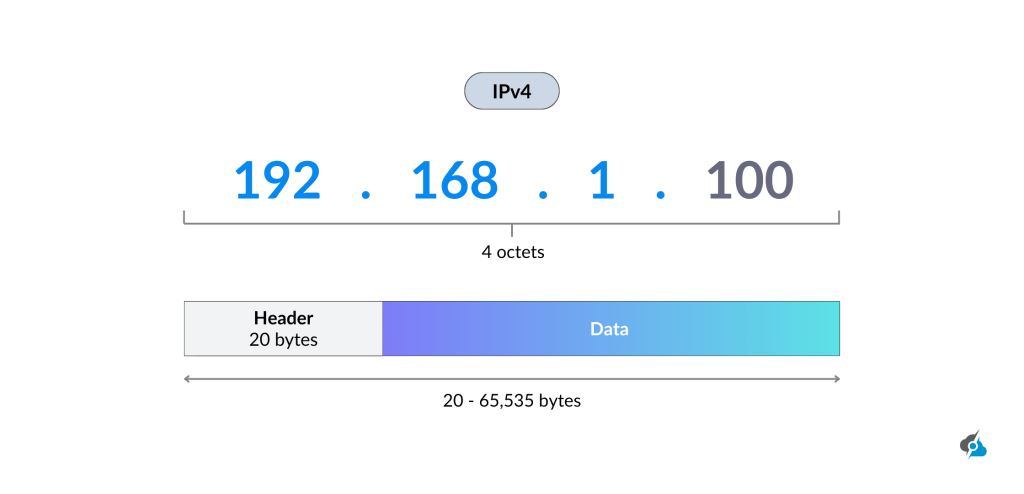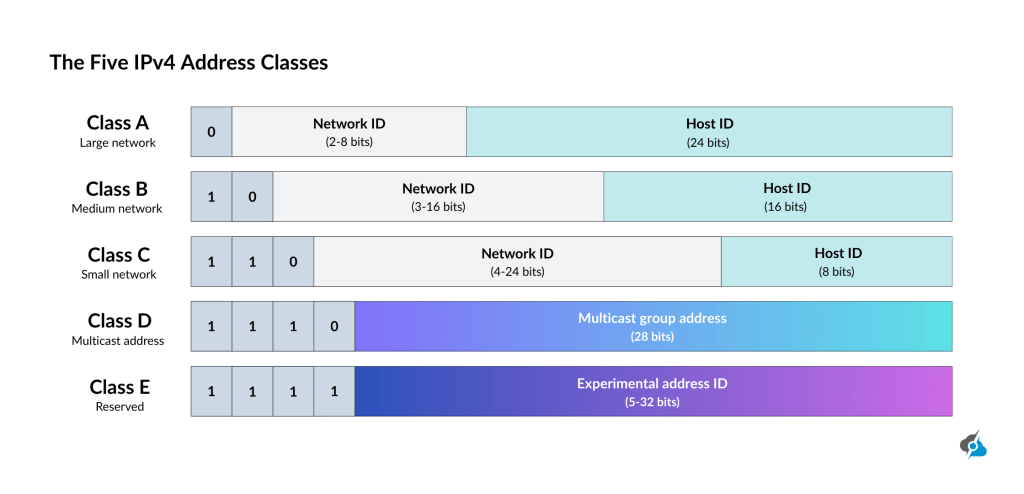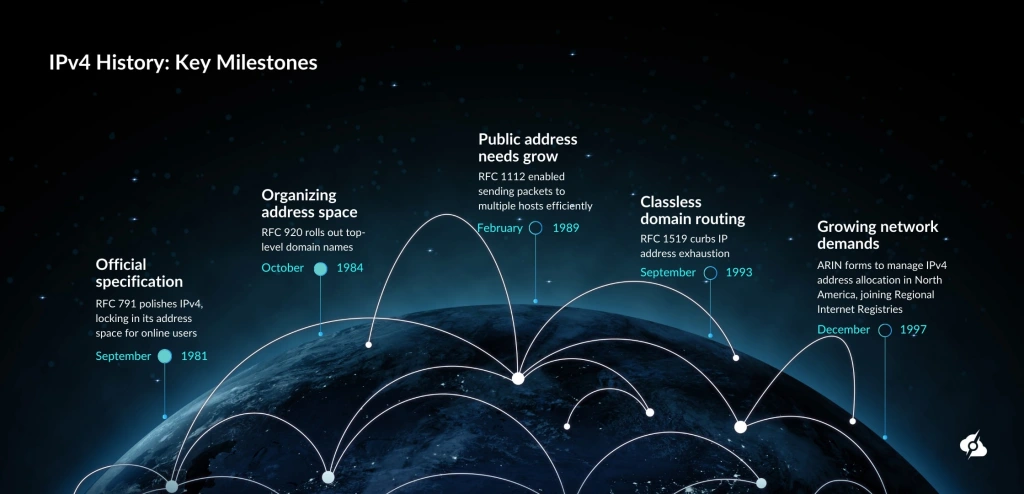When Was IPv4 Created? The Complete History & Evolution of IPv4 Addressing

The internet relies on a precise system of identifiers, enabling seamless device communication across global networks. At it’s core is IPv4, standardized in 1981, utilizes a 32-bit address space to provide different IPs to every device that power web communication.
Here, at ServerMania, we empower businesses with high-performance dedicated servers and cloud hosting through our AraCloud IaaS platform, which are designed for optimized network performance at every stage.
To further support your expansion, we now offer clean, flexible IPv4 address leasing, giving you instant access to trusted IP resources for new deployments, network scaling, and maintaining operational resilience.
Now, to understand IPv4 better, let’s explore the complete history and evolution!
Brief History of IPv4: The Birth
The history of IPv4 begins in the late 1970s, when the Internet was just a bold idea, only taking shape at the time. Born from the Advanced Research Projects Agency (ARPA), a research network funded by the US Department of Defense, IPv4 emerged to connect heterogeneous networks such as ARPANET.
By 1977, pioneers Vinton Cerf and Robert Kahn were tinkering with the Transmission Control Program, splitting it into the Transmission Control Protocol and Internet Protocol to handle data routing more smoothly. This groundwork led to the Internet Protocol Version 4, officially standardized in 1981 via RFC 791 by the Internet Engineering Task Force.
The IPv4 address system, was designed to assign unique addresses for a large network. On January 1, 1983, a flag day marked ARPANET’s switch to TCP/IP, cementing IPv4 as the foundation of the internet. Managed by the Internet Assigned Numbers Authority, it linked research facilities and universities, setting the stage for web communication.
This new standard wasn’t just a tech leap, it sparked a network that would grow above and beyond.
Early Internet Protocol Version 4 Design and Features:
When IPv4 was rolled out in 1981, the new design was a game-changer for linking networks that emerged from research establishments.
The Internet Protocol leaned on a 32-bit structure, crafted to handle online communication with enough flexibility to connect a large network of computers. Contrasting earlier systems like the Network Control Protocol, IPv4 paired with TCP/IP to split data into packets, ensuring seamless device communications.
Let’s explore some unique design features that made IPv4 what it is today:
Dotted Decimal Notation
The IPv4 32-bit addresses were written in a way anyone could understand—four numbers split by dots, like 192.168.1.100. This proposed standard made it easy for online users to read and manage connections.
Here, each number ranged from 0 to 255, turning binary into something human-friendly. It was a small but mighty choice that kept networks working.

The IPv4 Address Space
The dotted decimal notation offered an address space of 4.3 billion possible IPs, which was a big deal back then. Managed by the Internet Assigned Numbers Authority, it aimed to provide different address to every device.
However, as mobile phones and other networking devices joined the internet, this massive network pool started feeling tight, hinting that a new design is soon to arise.
Class-Based IP Addresses
IPv4 organized addresses into classes to match different network sizes.
Here’s how they broke down:
- Class A: Used for big networks and internet service providers.
- Class B: Primarily used for mid-sized groups, like universities.
- Class C: Utilized by smaller network setups, like local offices.
- Class D: Sending to multiple IP addresses (Group broadcasts).
- Class E: Used for experimental networking (off-limit testing).

| IPv4 Then Vs. IPv4 Now: Technical Specifications | ||
|---|---|---|
| IPv4 Then | IPv4 Now | |
| Structure | 32-bit, dotted decimal | The same 32-bit, dotted decimal |
| Capacity | 4.3 billion addresses (A, B, C, D, E) | 4.3 billion, uses CIDR for flexible allocation |
| Routing | Basic routing tables, class-based routing | Advanced routing with CIDR, optimized tables |
| Addressing | Manual allocation, IANA oversight | NAT, DHCP, and RIRs manage scarce addresses |
| Security | No built-in security, relied on external tools | Add-on security (e.g., IPSec), still no native |
| Compatibility | Designed for early ARPANET, limited devices | Dual-stack with IPv6, supports modern networks |
| Adoption | Core protocol for nascent internet | Coexists with IPv6, legacy systems dominant |
IPv4 Growth and Popularity – The Internet Boom!
The 1980s and ‘90s turned IPv4 into the core of the fast-growing internet. As the World Wide Web debuted in 1989, IPv4’s IP system-powered networks emerged, from National Science Foundation-funded campuses to startups in Middle East hubs.
It routed packets across networks, fueling the web communication for online users hitting domain names. By the mid-‘90s, public address demand surged as homes and businesses logged on, making IPv4 the backbone of a network that grew fast and wide.
To handle the rush, IPv4 rolled out several upgrades that kept it working to this day:
Network Address Translation
Network Address Translation was a lifesaver, allowing private networks to share one public IP address. Homes and offices could pack multiple IP addresses behind a single local network slot. This trick eased the IP allocation strain, especially in Latin America and Central Asia, where internet users multiplied.
It kept IPv4’s free pool from drying up as the global population rushed online.
Domain Name System
The Domain Name System made IPv4 addresses user-friendly by swapping numbers for names, such as “example.com.” This meant no more memorizing IPv4 address digits for TCP IP connections, and it spread fast, linking mobile phones and PCs to Asia Pacific servers or beyond.
This upgrade turned web communication into a breeze, driving World Wide Web growth!.
Classless Inter-Domain Routing
Classless Inter-Domain Routing reduced the need for rigid network class rules, slicing address space more flexibly with an internet mask. It lowered space exhaustion by handing out just enough addresses.
Throughout the years, from research networks to businesses, the inter-domain routing optimized IPv4 for vast networking, which is the solution in action until this day.
History of IPv4 Timeline
The journey of IPv4 spans decades, weaving through tech breakthroughs and global shifts. Below, key moments highlight its rise and evolution, drawn from the internet’s chaotic, thrilling growth.
- 1969: ARPANET, backed by the Advanced Research Projects Agency, pioneers packet switching, laying the research network foundation for TCP/IP and IPv4’s brief history.
- 1973: Vinton Cerf and Robert Kahn draft Transmission Control Program (TCP v1), a first stab at linking heterogeneous networks for future Internet Protocol designs.
- 1977: Jon Postel splits TCP into Transmission Protocol and IP, crafting TCP v3 by ‘78 to power IPv4’s proposed standard for big network links.
- 1980: IPv4 emerges in RFC 760, defining protocol version 4 to assign unique IPs across research facilities on the early internet.
- 1981: RFC 791 polishes IPv4, locking in its address space for online users, guided by the IETF for network growth.
- 1982: The United States Department of Defense adopts TCP IP as its military standard, cementing IPv4’s role in network reliability and expansion.
- 1983: RFC 882 births the DNS, simplifying “WWW” access by tying domain names to IPv4 addresses for users.
- 1984: RFC 920 rolls out top-level domain names (.com, .edu), organizing address space to fuel the internet’s early structure.
- 1988: Jon Postel founds the Internet Assigned Numbers Authority (RFC 1083), overseeing address allocation for networks emerged worldwide.
- 1989: Tim Berners-Lee’s World Wide Web invention spikes IPv4 use, as public address needs grow with internet users browsing domain names.
- 1991: The NSF drives “WWW” debuted growth, managing non-military DNS to scale IPv4 access.
- 1992: RIPE NCC and Asia Pacific’s APNIC launch, handling IPv4 address distribution to support address allocation in Europe and beyond.
- 1993: Classless Domain Routing (RFC 1519) curbs IP address exhaustion by refining network mask use in routing tables globally.
- 1994: Address Translation (RFC 1631) extends private addresses, easing space exhaustion for local network users in growing online hubs.
- 1995: The National Science Foundation greenlights domain name fees, tying IPv4 to commercial internet growth via DNS deals.
- 1997: ARIN forms to manage IPv4 address allocation in North America, joining Regional Internet Registries for network growth demands.
- 1998: IPv6 specs (RFC 2460) tackle IPv4 address space exhaustion as a long term solution, while IPv4 holds strong for internet needs.
- 2002: LACNIC starts managing addresses in Latin America, boosting network access across global population in 33 territories.
- 2004: AFRINIC becomes Africa’s internet registry, supporting IPv4 for Middle East and other regions’ web communication needs.
- 2005: The ERX project shifts IPv4 records to Regional Internet Registries, streamlining the IP allocation for global network efficiency.
- 2011: IANA’s free pool runs dry, with APNIC hitting IPv4 address exhaustion, spurring mitigation efforts like address transfers.
- 2012: RIPE’s IPv4 blocks vanish, while ARIN and APNIC test inter-RIR transfers to manage public IP address shortages effectively.
- 2014: LACNIC’s IPv4 pool nears depletion, underscoring the exhaustion as internet demand grows across world’s population.
- 2015: ARIN and RIPE exhaust IPv4 addresses, relying on transfers to meet great network needs in a strained internet landscape.
- 2017: IPv4 transfer markets boom, with rising prices reflecting pool scarcity for online users on big network setups.
- 2018: IPv6 adoption hits 20%, yet IPv4’s network legacy endures, powering web communication for world’s population.
| IPv4 History: Key Milestones | ||
|---|---|---|
| September 1981 | RFC 791 | Official specification of protocol version 4; replaced experimental protocols. |
| September 1981 | RFC 792 | Introduced Internet Control Message Protocol used for diagnostics like ping. |
| September 1981 | RFC 793 | Defined Transmission Control Protocol, crucial for reliable communication in IPv4. |
| October 1984 | RFC 917 | Supported troubleshooting and connectivity testing using IPv4. |
| October 1984 | RFC 919 | Defined broadcasting concepts in IPv4. |
| February 1989 | RFC 1112 | Enabled sending packets to multiple hosts efficiently. |
| September 1993 | RFC 1597 | Classless Domain Routing helps prevent IPv4 exhaustion. |
| May 1994 | RFC 1597 | Reserved IP blocks for internal use (e.g., 192.168.x.x) |
| February 1996 | RFC 1918 | Reaffirmed and formalized private address use to conserve public IPs. |

IPv4 Challenges and Evolution
IPv4, a game-changer for it’s time, faced many challenges during the internet spike, motivating many tweaks and adjustments. Let’s name a few of them:
IPv4 Address Exhaustion
The biggest problem for IPv4 was running out of available IP addresses.
With only 4.3 billion possible IPs, the surge of devices such as phones, laptops, and smart home gadgets shrunk the pool, especially by 2011 when the global reserves dried up. Hence, workarounds like sharing addresses have helped quite a lot, but was only a temporary solution for the foreseeable future.
Routing Complexity
IPv4’s routing got messier as the internet expanded. Older setups struggled to handle the flood of data paths, slowing things down and making networks trickier to manage. Tweaks like smarter routing tables came in, but the scale of connections kept pushing the system to its limits, begging for a new approach.
Security Weaknesses
Security wasn’t designed into IPv4’s original layer, leaving it exposed. So, without the built-in defenses, networks leaned on addons to block threats. This drove efforts to layer on protection, but it has also highlighted the need for a system with safety from the ground up.
Compatibility Struggles
As the internet kept evolving and the network grew, new smart devices started to arise, IPv4 was not ready to handle modern needs and requirements. Mixing it with modern systems caused problems, like clunky handoffs or extra setup steps to keep things talking.
Tip: To understand more about protocol security, learn how to block an IP.
IPv4 Today & IP Address Space Exhaustion
As of 2025, IPv4 remains the foundation of the global web infrastructure, reliably supporting a vast array of connections despite its 1981 origins.
Although new protocols like IPv6 are gaining adoption, IPv4’s presence ensures its ongoing relevance, with dual-stack configurations facilitating coexistence with modern standards.
The proven stability and compatibility make IPv4 irreplaceable, at least not completely for organizations worldwide, maintaining seamless data transmission. The future is IPv4 is unclear, but one thing is for certain; its robust legacy will guarantee delivery for for years to come, even as the newer systems rise.
Note: Learn more about IPv4 vs IPv6 – what’s the difference and which is better?
Did You Know?
IPv4’s creation hides some fascinating, lesser-known stories from its early days! Here are some curious facts sourced from the early IP addresses development:
- In 1977, a test sent data from California to London via radio, satellite, and cable, proving IPv4 could link global networks seamlessly.
- During early IPv4 trials, engineers used a mobile van to relay packets between radios, testing real-time connectivity.
- The first IPv4 standard, RFC 760, was drafted in months by a small team racing to unify the online networks forever.
- IPv4’s creators, like Vinton Cerf, wrongfully assumed that IPv4 would be replaced by the 1990s due to scaling limits.
- A 1980s IPv4 bug from a misconfigured address crashed Stanford’s network, delaying research for hours.
Summary
IPv4 has been at the core of the internet’s growth for decade, and its role remains just as important today. As demand for reliable IP resources continues to rise, ServerMania is here to help you stay connected and ready for what’s next.
Looking to lease reliable IPv4 addresses from a provider you can count on? IPv4 Leasing is now available at ServerMania. We offer flexible terms, clean IPs, and fast provisioning. Get the IPs you need today!
Frequently Asked Questions:
When did IPv4 come out?
IPv4 was standardized in 1981 via RFC 791 by the IETF, building on Advanced Research Projects Agency work from the late 1970s.
Who Created IPv4?
IPv4 was developed by Vinton Cerf, Robert Kahn, and other researchers in the late 1970s, and later standardized by the IETF in 1981.
When did IPv4 become the internet’s standard?
In 1982, the US Department of Defense made TCP IP the military network standard, boosting IPv4’s role across the web.
What’s the difference between IPv4 and IPv6?
IPv4 uses a 32-bit IP space (4.3 billion unique addresses), while IPv6 offers 128-bit for a long term fix to the IP exhaustion.
When did IPv4’s address classification system take shape?
In 1981, IPv4 used a significant bit in RFC 791 to define class-based different IP addresses, organizing massive network connections for web growth.
When did IPv4 expand it’s connectivity in different regions?
IPv4 boosted web communication in the Asia Pacific by the early 1990s, with APNIC forming in 1992 to manage IPv4 addresses for the global web.
When did IPv4 start to support researchers in isolated areas?
By the mid-1980s, IPv4 powered connectivity for research establishments in places like the North Atlantic islands, enabling online communication via public IP systems.
When did Regional Registries form for IPv4?
RIPE NCC and APNIC started in 1992, followed by ARIN (1997) and LACNIC (2002), managing IP allocation globally.
Was this page helpful?

